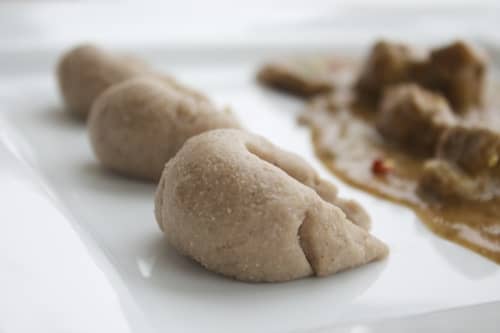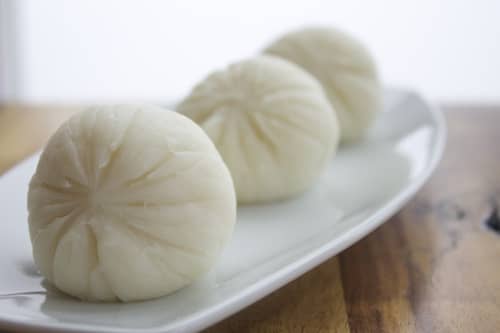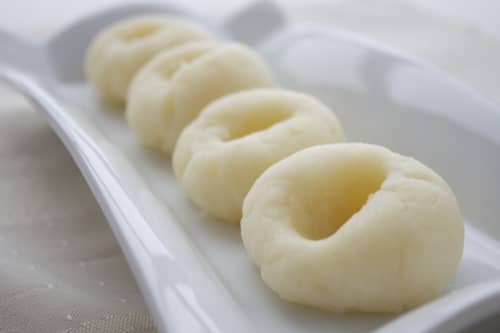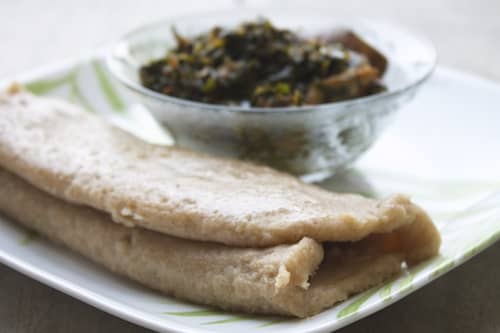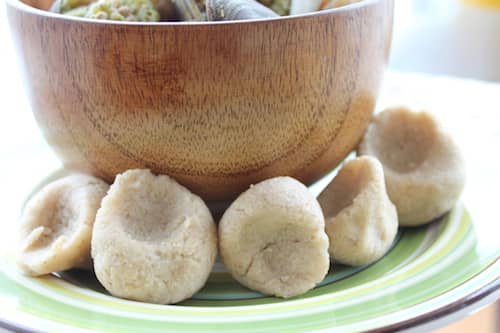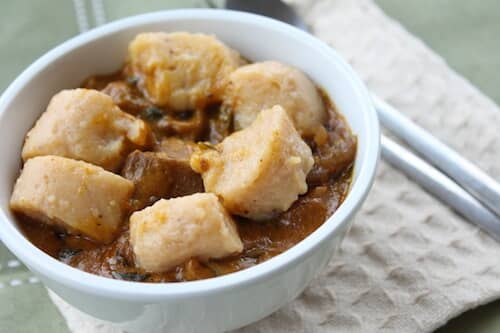9 Swallows For Every Palate
By Abby SoetanPublished: January 12, 2015
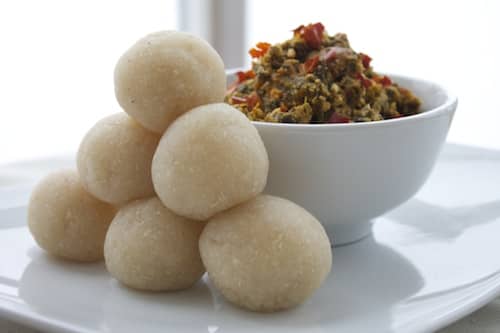
The term “swallow” is widely used in Nigeria to describe starchy foods that are cooked to a dense paste and eaten with various soups. They are called “swallows” because of the method of eating, i.e. using your fingers, take a morsel of paste, dip it in soup and swallow it. Other popular names for swallow are okele (a Yoruba word) and ilo ihe (an Igbo word) and bolus (from the latin, ball, meaning a mass of food ready to swallow”). Below is a list of some popular Nigerian swallows and their nutrition facts.
1. Eba is made from dried and grated cassava, popularly known as “garri.” It is very rich in carbohydrates, containing 92.9g of carbohydrates and 358 calories per 100g; but it is low in other nutrients like vitamins, minerals, and protein. Garri can be either yellow in color or off-white in color, depending on the method of preparation — when prepared with palm oil, it turns yellow and when prepared without palm oil, it remains off-white. Eba is usually eaten with okra soup, egusi (melon soup) or ofe onugbu (bitter leaf soup).

Make Eba
Ingredients: 1 ½ cup water; 1 cup garri
i. Boil water and pour in a bowl.
ii. Sprinkle garri into the boiled water, cover and microwave for 2 minutes. (This step can also be done in a pot over medium heat)
iii. Take out of the microwave and use a wooden spoon (omorogun) to stir till it forms a homogenous mixture
iv. Serve hot with your choice of soup
2. Amala is popularly prepared from yam skins and is locally known as àmàlà iṣu. Once the yams skins are processed, the flour (known as elubo) itself is white in color but it turns to its characteristic rich brown color when added to water and cooked. Amala can also be prepared from fermented cassava flour. When made from cassava flour, the amala, then called àmàlà làfún, remains white in color even after cooking. Yam flour is the healthier of the two as it contains fewer calories and more protein per 100g than cassava flour. However, both should still be enjoyed in moderation. Amala is popularly eaten with Ewedu (Jute leaf soup), Gbegiri (beans soup) or Ogbono/Apon (African wild mango soup).
Make Amala
Ingredients: 2 cups yam flour; 5 cups water (divided)
i. Boil water in a pot then reduce heat to low. Set 1 cup of water aside
ii. Add yam flour all at once to the water then stir with a wooden spoon till all the water is absorbed. Add the reserved cup of water and leave amala to simmer for 1-2 minutes
iii. Using the spoon, stir and knead the amala until it forms a smooth and soft dough

3. Pounded yam, also known as iyan, is one of the many yam recipes eaten in Nigeria. As the name suggests, it is boiled white yam that has been pounded until it becomes homogenous and semi-stretchy dough. Yam is a great source of carbohydrates and is calorie dense, thus it is beneficial for individuals who are looking to gain weight. It contains 356.25 calories, 80g carbohydrates, 0.8g fat and 7g proteins per 100g. Pounded yam is widely consumed with Egusi (melon soup) or Efo Riro (leafy vegetable soup).
Make Pounded Yam
Pounded yam can be prepared from yams directly or yam flour
Ingredients: Yam tuber; water
i. Peel the yam, dice into small pieces and boil till it becomes tender
ii. Put yam in a large mortar (or a very durable pot) and use a pestle to pound the yam till there are no lumps
iii. Add a little hot water so that the yam forms a consistent paste. You may also add more water to reduce thickness according to your preference
iv. Serve with desired soup
Ingredients: 1 cup water; 1/3 cup pounded yam flour
i. Boil 1 cup water in a medium pot
ii. On medium heat, add 1/3 cup of pounded yam flour to the water and mix well, using a wooden spoon, until there are no lumps
iii. Cook for 5-10 minutes, mixing continuously
4. Semovita is a very easy Nigerian swallow to prepare, thus it is a good substitute for pounded yam and amala, which are more difficult to cook. Its particles are coarse, making it a more textured swallow similar to Eba, but without the slight vinegar/sour taste. Because of its high energy content, it is beneficial to individuals trying to gain weight.
Make Semovita
Ingredients: 1 cup semovita flour; 1 and 2/3 cups of water
i. Boil the water in a pot and set aside 2/3 cup of water.
ii. Add the semovita with one hand while stirring simultaneously with the other until all the semovita is gone. Keep stirring until it becomes smooth and hard
iii. Add the rest of the hot water previously set aside, cover the pot and cook for 1-2 minutes. Then mix thoroughly, take off the heat and set aside to cool for 1 minute.
iv. Serve with preferred soup
5. Semolina is a coarse and fibre-rich particle made from durum wheat, which is also used in making pasta. It is low in fat and high in carbohydrate, offering a lot of energy as well as some important minerals like vitamin B and E. It is a very versatile ingredient, eaten not only in swallow form but also as a breakfast cereal and to make couscous (which is cooked like rice). As semolina is high in gluten, individuals with gluten sensitivity should take this into consideration before consuming it. Each 100g of semolina contains 360 calories.
Make Semolina
Ingredients: 1 cup semolina flour; 1 and 2/3 cups water
i. Boil the water in a pot and set aside 2/3 cup of water.
ii. Add the flour little by little, stirring continuously until all of it is used. Keep stirring until it becomes smooth and hard
iii. Add the rest of the hot water, cover the pot and cook for 1-2 minutes. Then mix thoroughly, take off the heat and set aside for 1 minute to cool.
iv. Serve in a dish with preferred soup
6. Wheatmeal is a light brown swallow that is made from whole grain wheat. As with all wheat-based swallows, wheat meal is high in protein and rich in fibre. Its consumption facilitates the digestive process, and helps to cleanse the colon. Wheat meal is typically eaten with Okra soup, Efo (vegetable soup) or Edikaikong (Efik vegetable soup).
Make wheat meal swallow
Ingredients: 2 cups water; 2.5 cups wheat meal
i. Boil 2 cups of water and put 1 cup in a pot and set aside the other cup
ii. Add the wheat meal to the pot and keep turning, using a wooden spoon, until it is smooth
iii. Add the 2nd cup of water to the wheat meal, cover the pot and allow to cook on low heat for 10 minutes
iv. Mix and turn the wheat meal till it is firm and consistent
v. Serve hot with soup of your choice
7. Tuwo shinkafa is a thick rice pudding popularly eaten in the northern part of Nigeria. It is locally prepared from short-grain rice that is cooked pulp, but can also be made using rice flour. Tuwo is usually eaten with Miyan Kuka (baobab leaf soup) or Miyan Taushe (Nigerian pumpkin soup). It is rich in energy, containing 80.127g carbohydrate and 366 calories per 100g.
Make Tuwo shinkafa
Ingredients: 1 cup rice flour; 2 cups water; ½ teaspoon salt
i. Combine salt and water in a non-stick pot and bring to a boil
ii. Sprinkle rice flour in water and stir quickly with a wooden spoon
iii. Reduce heat to low and continue stirring. Cook for about 10 minutes till tuwo becomes a thick dough
iv. Leave to cool for 2 minutes, then serve with choice of soup
8. Oatmeal fufu, which is made by cooking blended whole grain oats in water till it forms a paste, is one of the more modern and healthy swallow alternatives. Containing 3.98g of fibre per cup, oatmeal fufu helps to lower cholesterol levels, reduce the risk of cardiovascular diseases, and stabilize blood sugar. For individuals with high blood sugar and cholesterol levels, oatmeal fufu is a great substitute to maintain a healthy diet while still enjoying traditional meals.
Click here for our oatmeal fufu recipe.
9. Plantain Amala is an alternative amala recipe, prepared by blending and cooking unripe plantains until the soft dough forms. The use of unripe plantain is advantageous as it contains less sugar than ripe plantains. Eating plantain amala can help one maintain resilient skin, as the plantain itself is a good source vitamin A, with 37.5% per 100g. It also contains adequate levels of potassium, which is an important factor in stabilizing blood pressure and heart rate.
Click here for our plantain amala recipe.
Over to you. What’s your favorite swallow and soup? Share in the comment box below.
Like what you're reading? Sign up for our free newsletter and never miss a post! Plus get a FREE digital version of our Issue No.10 with sign up.

- Recipe: Heartwarming Catfish Pepper Soup - March 31, 2015
- Coconut Chicken Curry - April 29, 2015
- Plantain Amala - January 14, 2015
- Popcorn Shrimp - December 16, 2014
- Coconut Semolina Porridge - April 7, 2015
- Recipe: Twice Baked Sweet Potato - November 25, 2014
- This Seafood Okra Soup And Oatmeal Fufu Is Good For Your Waistline - November 3, 2014
- 9 Swallows For Every Palate - January 12, 2015
- Coconut Granola Bars - April 29, 2015
- Coconut-Pineapple-Spinach Smoothie - April 29, 2015




